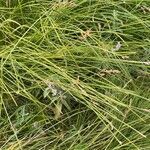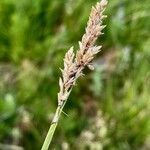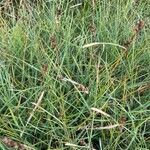Stems densely clustered, 3–10 dm, aphyllopodic, rather slender above; lvs ± elongate, ± flat, mostly 1–2.5 mm wide; sheaths ventrally pale and red-dotted, prolonged 2–3 mm beyond the base of the blade; spikes androgynous, ± numerous, small, sessile, aggregated into a compact but branched infl 2–3.5(–5) cm long and seldom over 1 cm thick; bracts small, setaceous or almost like the pistillate scales; stamens 3 (in spite of the name); scales largely hyaline-scarious and stramineous or brownish, with firmer, sometimes shortly excurrent midrib; perigynia ovate or lance-ovate, 2.4–3 mm, half as wide, usually dark brown, shining, ± spreading, very firm and thick-walled, the nerveless ventral surface slightly convex and often exposed in the spike, the dorsal surface strongly convex and with a median thin, often depressed and pale strip (an extension of the dorsal suture) bordered by a pair of veins and reaching to the base; beak ± abruptly differentiated from the body of the perigynium, coarse, serrulate-margined, often pale or greenish; achene lenticular; 2n=60. Swamps, wet meadows, and Sphagnum-bogs; circumboreal, s. to N.J., Pa., Ind., Mo., Colo., and Calif.
Rhizome shortly creeping, indurate. Culms loosely tufted, 30-45[-90] cm tall, compressed trigonous, scabrous above, clothed with brown or dark brown bladeless sheaths at base. Leaves shorter than culm, blades linear, 2-3 mm wide, flat, margins scabrous, apex acuminate. Involucral bracts setaceous, shorter than inflorescence. Inflorescence spicate-paniculate, 2-3.5 cm; sometimes lowest spike ± branched; spikes androgynous, broadly ovate, 5-7 mm. Female glumes ferruginous-brown, broadly ovate, ca. 3 × 2 mm, 3-veined, margins pale hyaline, apex acuminate. Utricles ferruginous-brown, greenish above, subequaling glume, broadly ovate, plano-convex, ca. 3 × 2 mm, leathery, with 4 or 5 short veins at base abaxially, nerveless adaxially, base broadly subcordate, spongy, shortly stipitate, distal margins denticulate, apex gradually contracted into a serrulate-margined and narrowly winged beak ca. 1 mm. Nutlets tightly enveloped, obovate, plano-convex, ca. 1.4 × 1.2 mm, base broadly cuneate, shortly stipitate; style base slightly thickened; stigmas 2. Fl. and fr. Jul. 2n = 48, 50, 54, 60.
Culms (1–)2–90 cm. Leaves: sheaths adaxially whitish, conspicuously red dotted, truncate or convex at mouth, prolonged 0.4–4(–6) mm beyond base of blade; ligules 8–57 mm; foliage leaf blades 14–30(–47) cm × 1–2.5 mm. Inflorescences bisexual, straight, little interrupted, ± compound (short branch at least on most proximal node or, occasionally, unbranched) , 2–5(–6) × 0.6–1.4(–1.7) cm, proximal 0–3 branches slightly overlapping 1 above; basal branch (when present) with 2–12 spikes; proximal internode 3–7(–10) mm. Pistillate scales straw colored or brownish, 1.5–2.7 × 0.9–1.6 mm, as wide as perigynia at base, narrower distally. Perigynia ± spreading, olive to dark chestnut brown, stongly 4–6-veined and finely 2–4-veined abaxially, with narrow median strip extending full length (grooved aspect emphasized by pair of bordering veins), often membranous flap toward apex, narrowly deltoid-ovoid, unequally biconvex, (2–)2.3–2.5(–2.9) × 1–1.4 mm, shiny; beak 0.9–1.1 mm. Achenes broadly compressed-ovoid, 1.4–1.7 × 0.7–1 mm. 2n = 48, 50, 54, 60.
Shoots close together from woody, dark brown rhizomes, loosely tufted, not tussock-forming, pale or bright green, to 55 cm high. Inflorescence a spike-like greenish-brown panicle 1.5-5 cm long. Spikes many, sessile, ± densely clustered, male flowers at top. Utricles dark brown, nerved on one face; beak-margins scabrid. Stigmas 2.




